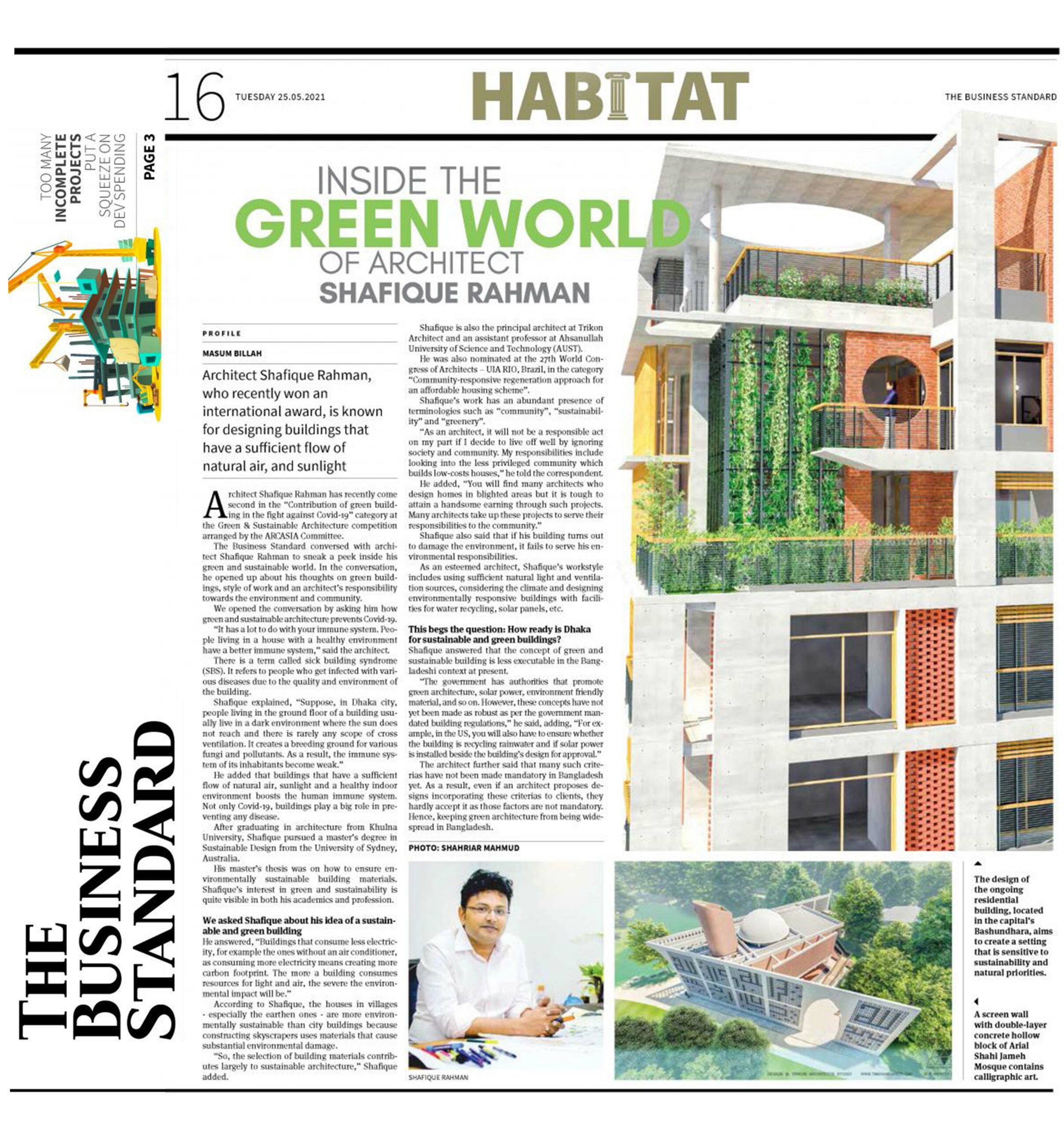

Trikon Architects was Featured In The National Newspaper “The Business Standard”
The national newspaper “The Business Standard” features Architect Shafique Rahman.
“The Business Standard” a recognized national newspaper in Bangladesh published an interview with Architect Shafique Rahman on 25th May 2021.
The Business Standard conversed with architect Shafique Rahman to sneak a peek inside his green and sustainable world. In the conversation, he opened up about his thoughts on green buildings, style of work, and an architect’s responsibility towards the environment and community.
We opened the conversation by asking him how green and sustainable architecture prevents Covid-19.
“It has a lot to do with your immune system. People living in a house with a healthy environment have a better immune system,” said the architect.
There is a term called sick building syndrome (SBS). It refers to people who get infected with various diseases due to the quality and environment of the building.
Shafique explained, “Suppose, in Dhaka city, people living on the ground floor of a building usually live in a dark environment where the sun does not reach and there is rarely any scope of cross ventilation. It creates a breeding ground for various fungi and pollutants. As a result, the immune system of its inhabitants becomes weak.”
He added that buildings with a sufficient flow of natural air, sunlight, and a healthy indoor environment boost the human immune system. Not only Covid-19, but buildings also play a big role in preventing any disease.
After graduating in architecture from Khulna University, Shafique pursued a master’s degree in Sustainable Design from the University of Sydney, Australia.
His master’s thesis was on how to ensure environmentally sustainable building materials. Shafique’s interest in green and sustainability is quite visible in both his academics and profession.
We asked Shafique about his idea of a sustainable and green building
He answered, “Buildings that consume less electricity, for example the ones without an air conditioner, as consuming more electricity means creating more carbon footprint. The more a building consumes resources for light and air, the more severe the environmental impact will be.”
According to Shafique, the houses in villages – especially the earthen ones – are more environmentally sustainable than city buildings because constructing skyscrapers uses materials that cause substantial environmental damage.
“So, the selection of building materials contributes largely to sustainable architecture,” Shafique added.
Shafique is also the principal architect at Trikon Architect and an assistant professor at Ahsanullah University of Science and Technology (AUST).
He was also nominated at the 27th World Congress of Architects – UIA RIO, Brazil, in the “Community-responsive regeneration approach for an affordable housing scheme” category.
Shafique’s work has an abundant presence of terminologies such as “community”, “sustainability” and “greenery”.
“As an architect, it will not be a responsible act on my part if I decide to live off well by ignoring society and community. My responsibilities include looking into the less privileged community which builds low-cost houses,” he told the correspondent.
He added, “You will find many architects who design homes in blighted areas but it is tough to attain a handsome earning through such projects. Many architects take up these projects to serve their responsibilities to the community.”
Shafique also said that if his building turns out to damage the environment, it fails to serve his environmental responsibilities.
As an esteemed architect, Shafique’s workstyle includes using sufficient natural light and ventilation sources, considering the climate, and designing environmentally responsive buildings with facilities for water recycling, solar panels, etc.
This begs the question: How ready is Dhaka for sustainable and green buildings?
Shafique answered that the concept of green and sustainable building is less executable in the Bangladeshi context at present.
“The government has authorities promoting green architecture, solar power, environment-friendly material, etc. However, these concepts have not yet been made as robust as per the government-mandated building regulations,” he said, adding, “For example, in the US, you will also have to ensure whether the building is recycling rainwater and if solar power is installed beside the building’s design for approval.”
The architect further said that many such criteria have not been made mandatory in Bangladesh yet. As a result, even if an architect proposes designs incorporating these criteria to clients, they hardly accept it as those factors are not mandatory. Hence, keeping green architecture from being widespread in Bangladesh.